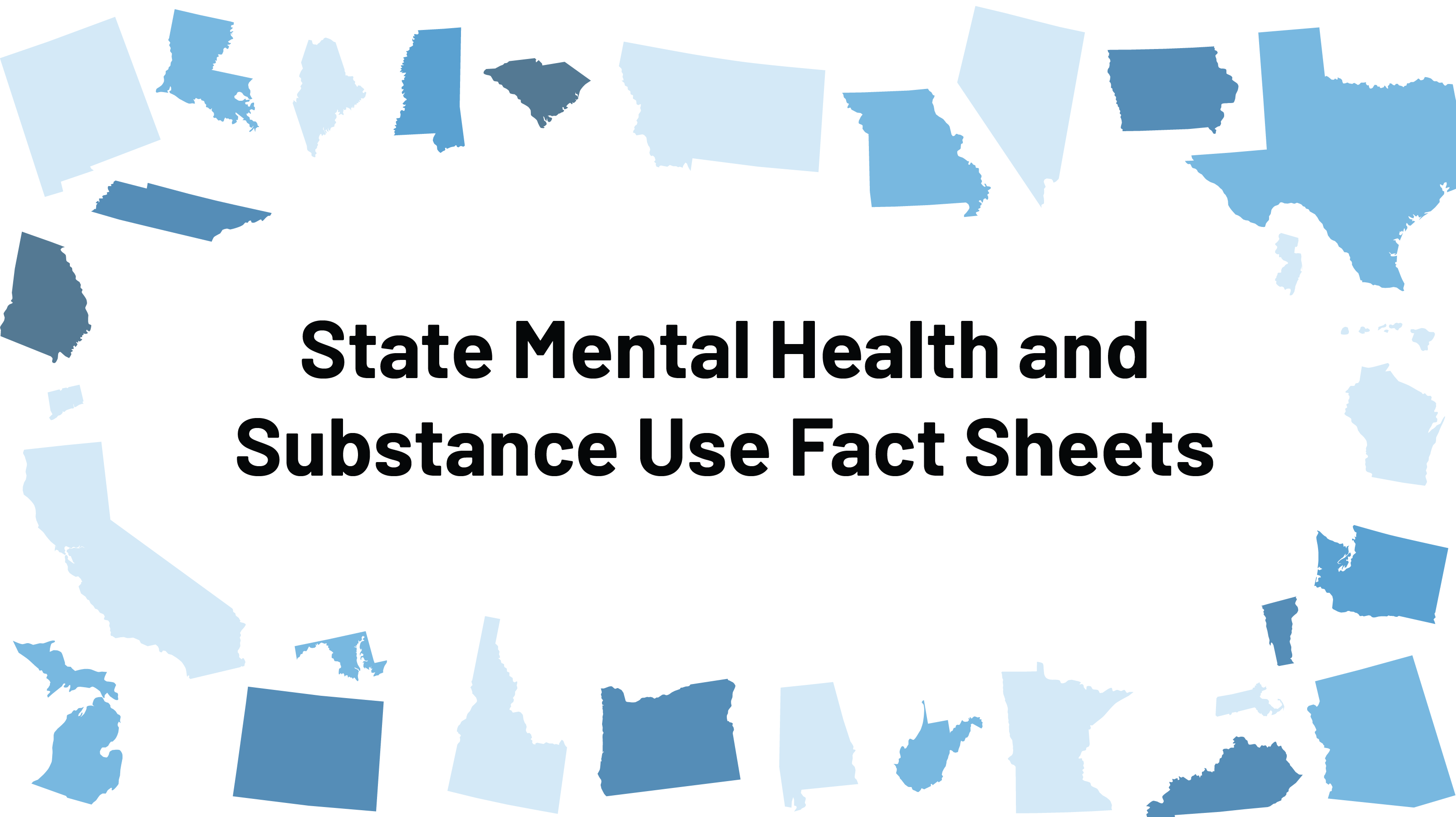Key Findings
The state-level facts sheets explore the prevalence of mental illness and substance use and related deaths, and access, affordability, and costs of care. Key findings include:
Mental health symptoms have increased during the COVID-19 pandemic. From April 28 – May 10, 2021, 30.7% of adults in the U.S. reported symptoms of anxiety and/or depressive disorder, up from 11.0% in 2019.
- The states with the highest percentage of adults reporting symptoms of anxiety and/or depressive disorder from April 28 – May 10, 2021 were Arkansas (35.5%), Kentucky (35.2%), Louisiana (34.3%), Oklahoma (34.3%), and Alaska (33.8%).
- The states with the lowest percentage of adults reporting symptoms of anxiety and/or depressive disorder from April 28 – May 10, 2021 were Hawaii (23.2%), Minnesota (24.1%), Montana (24.1%), South Dakota (24.4%), and Rhode Island (24.5%).
Among adults who reported symptoms of anxiety and/or depressive disorder, 24.2% reported needing, but not receiving, counseling or therapy, based on data from April 2021.
- The states with the highest percentage of adults who reported symptoms of anxiety and/or depressive disorder and had an unmet need for counseling or therapy in April 2021 were Vermont (38.8%), South Dakota (35.9%), Idaho (32.5%), Connecticut (31.9%), and Louisiana (31.6%).
- The states with the lowest percentage of adults who reported symptoms of anxiety and/or depressive disorder and had an unmet need for counseling or therapy in April 2021 were New Jersey (15.1%), Iowa (16.6%), Alabama (18.9%), Delaware (19.1%), and Nebraska (19.6%).
Deaths due to drug overdose increased during the pandemic, primarily driven by synthetic opioid use. In the U.S., in the 12-month period ending in September 2020, there were 27.4 deaths due to drug overdose per 100,000, up from 21.3 per 100,000 in 2019.
- States with the highest drug overdose deaths in the 12-month period ending in September 2020 were the District of Columbia (73.5 per 100,000), West Virginia (72.1 per 100,000), Delaware (48.5 per 100,000), Kentucky (43.7 per 100,000), and Ohio (43.7 per 100,000).
- States with the lowest drug overdose deaths in the 12-month period ending in September 2020 were South Dakota (9.1 per 100,000), Nebraska (10.5 per 100,000), Iowa (13.3 per 100,000), North Dakota (13.3 per 100,000), and Texas (13.8 per 100,000).
Suicide is one of the leading causes of death in the U.S. and has increased in almost every state over time. In 2019, the age-adjusted suicide rate was 13.9 per 100,000.
- States with the highest suicide rates in 2019 were Wyoming (29.6 per 100,000), Alaska (28.5 per 100,000), Montana (26.2 per 100,000), New Mexico (24.1 per 100,000), and Colorado (22.1 per 100,000).
- States with the lowest suicide rates in 2019 were the District of Columbia (6.1 per 100,000), New Jersey (8.0 per 100,000), New York (8.3 per 100,000), Massachusetts (8.6 per 100,000), and Maryland (10.3 per 100,000).
In 2018-2019, approximately one-third (35.0%) of adults with serious mental illness (SMI) in the past year did not receive mental health treatment.
- The states with the highest percentage of adults with SMI that did not receive mental health treatment were the District of Columbia (47.0%), Georgia (46.6%), Alaska (45.7%), Oklahoma (45.2%), and Texas (44.7%).
- The states with the lowest percentage of adults with SMI that did not receive mental health treatment were Wisconsin (14.4%), North Dakota (19.7%), West Virginia (22.8%), South Dakota (23.9%), and Utah (24.4%).
Across all states, average out-of-pocket spending for adults with mental illness enrolled in large employer health plans is higher than average out-of-pocket spending for adult enrollees without mental illness ($1,347 vs. $671).
- Average out-of-pocket spending for adults with large employer coverage who have a mental illness is highest in Connecticut ($1,753), Wyoming ($1,739), North Dakota ($1,698), Montana ($1,659), and Idaho ($1,617).
- Average out-of-pocket spending for adults with large employer coverage who have a mental illness is lowest in Michigan ($998), Massachusetts ($1,048), California ($1,106), Iowa ($1,106), and Wisconsin ($1,113).
Note: For more state-level data, visit our Mental Health and Substance Use page on KFF’s State Health Facts. Through State Health Facts’ custom state reports, comparisons can be made across select states and indicators.
Mental health and substance use disorders remain a key policy issue at the national and state level, especially in light of the COVID-19 pandemic. The recently passed American Rescue Plan Act allocates funding for mental health and substance use disorder services, with a portion designated for children and adolescent’s mental health. The need for mental health care has increased even as some people have lost health insurance due to unemployment during the pandemic. This will likely exacerbate longstanding access to care issues for mental health and substance use treatment services. As policymakers address the many issues that the pandemic and economic crisis have created or highlighted, data will be pivotal to underpin policy action directed at addressing longstanding and developing issues in mental health care.

